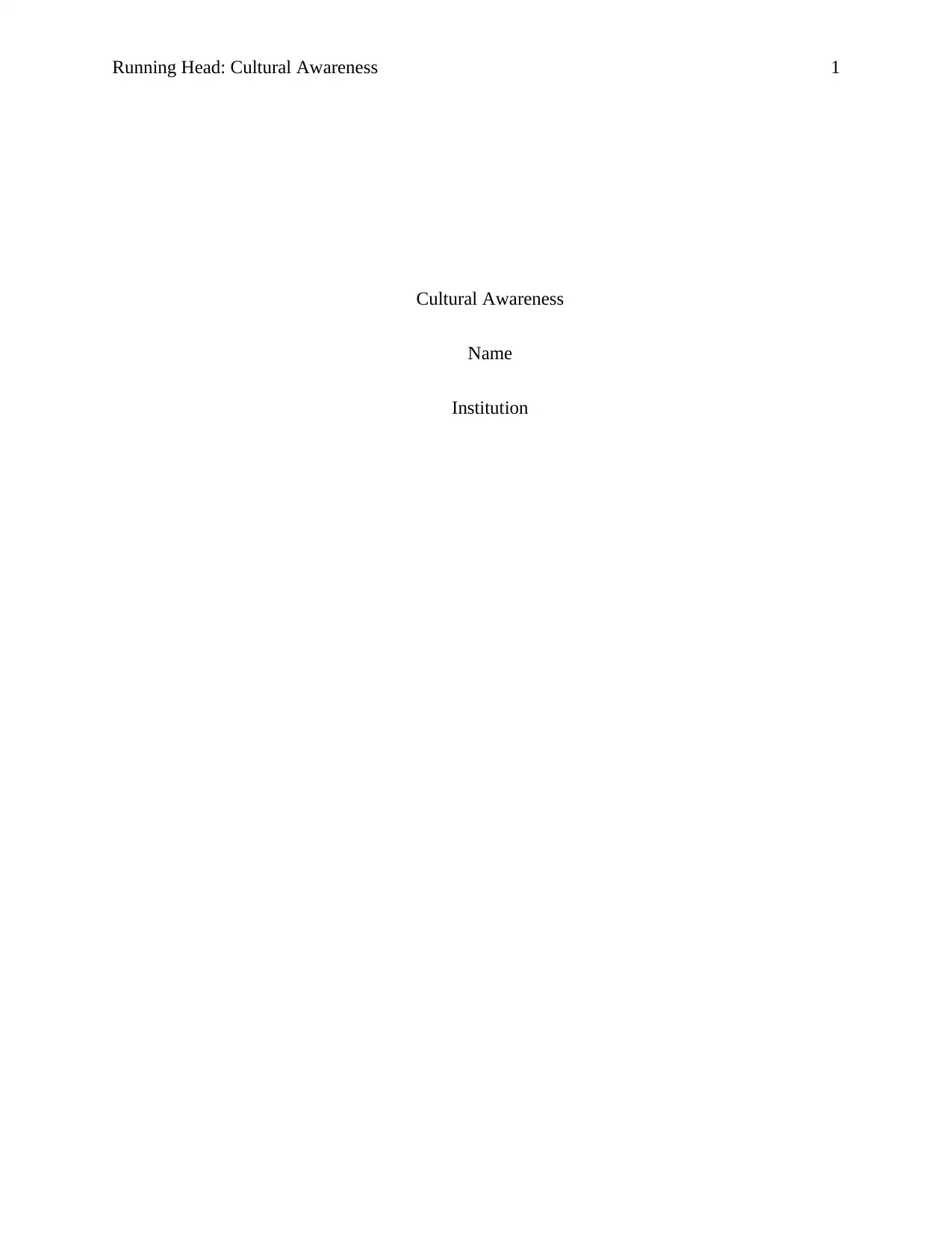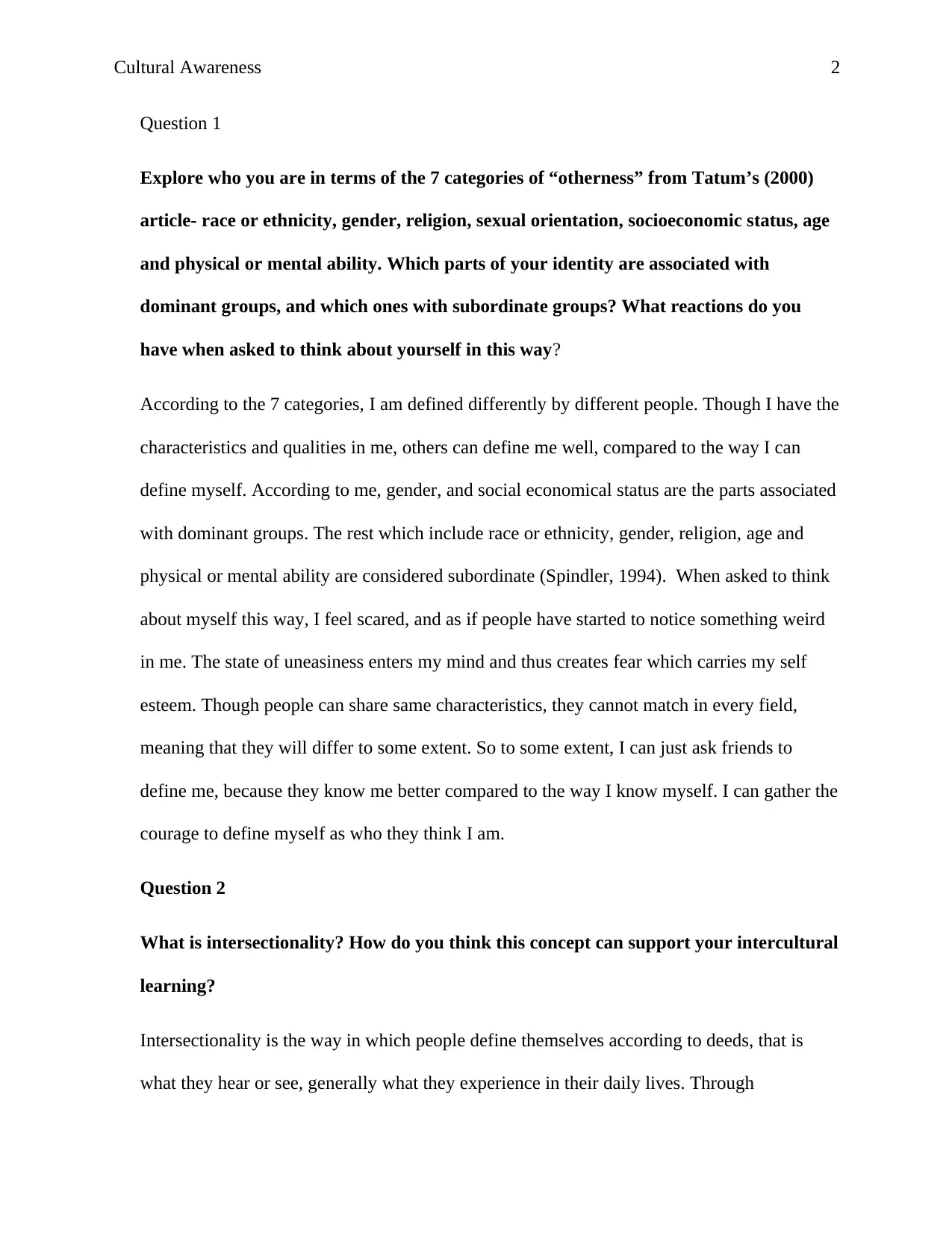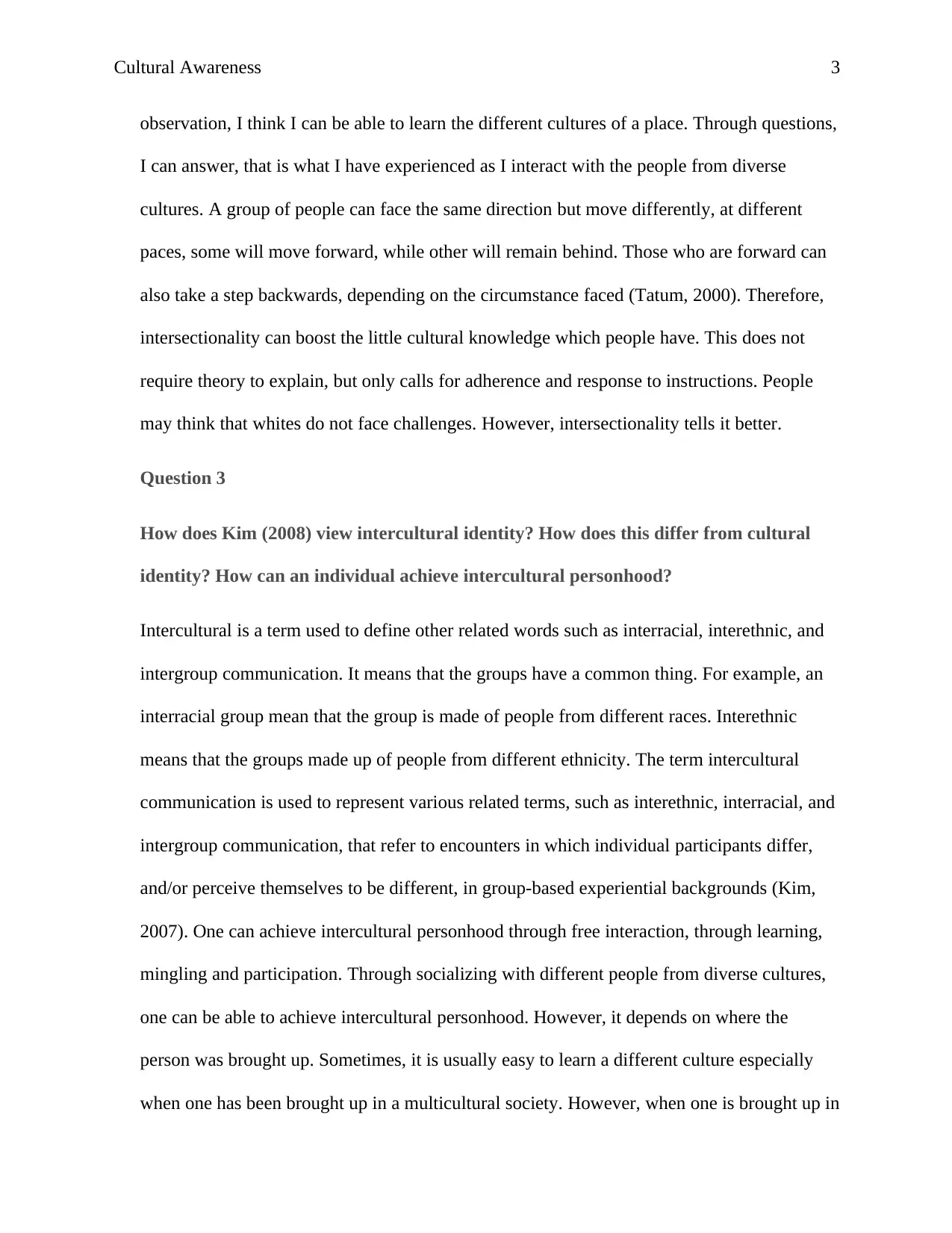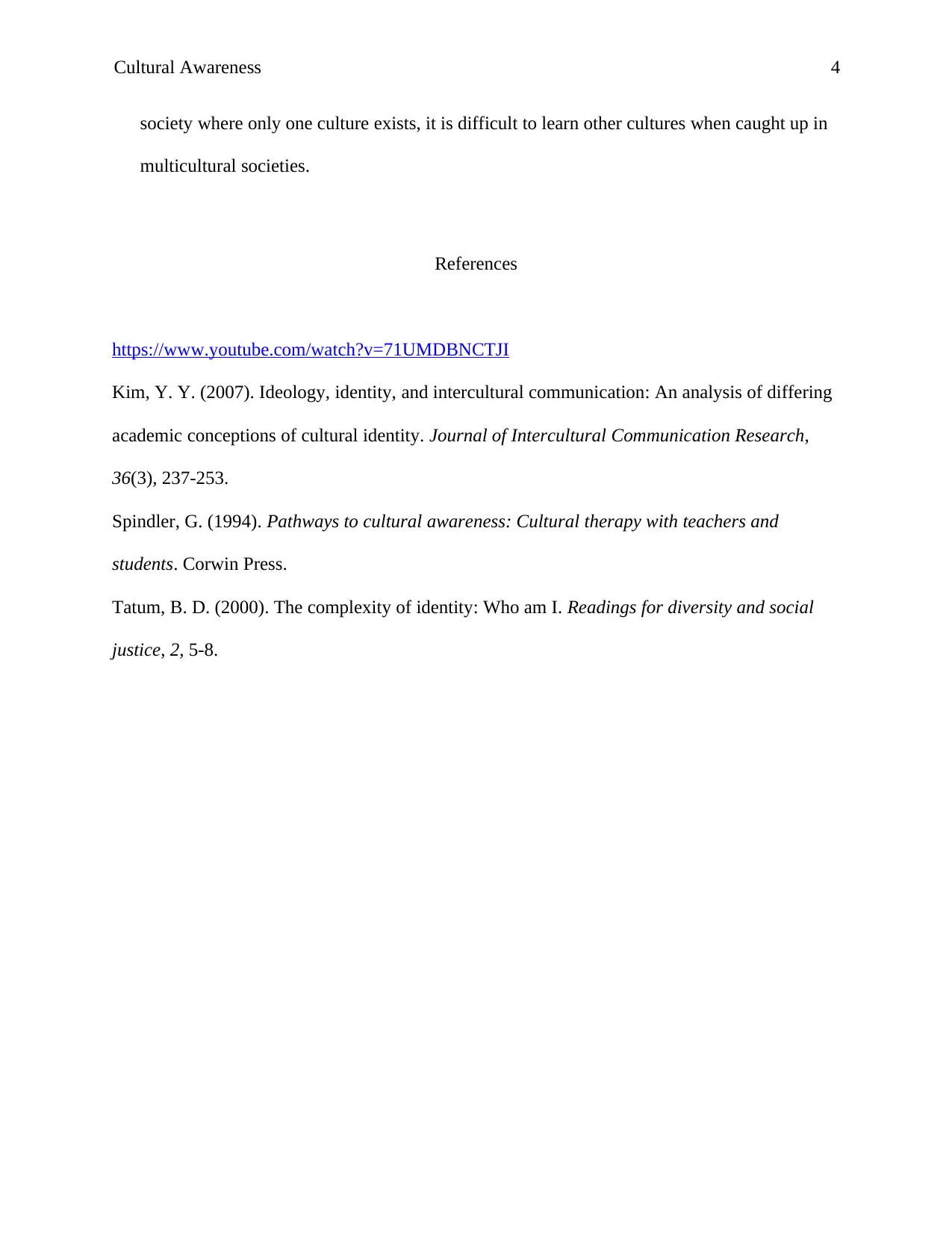Cultural Awareness Essay: Identity and Intersectionality
VerifiedAdded on 2021/06/17
|4
|794
|103
Essay
AI Summary
This essay explores the concept of cultural awareness, examining identity through the lens of seven categories of "otherness" as defined by Tatum (2000). The author reflects on their own identity, identifying aspects associated with dominant and subordinate groups, and the emotional responses elicited by this self-reflection. The essay then delves into intersectionality, explaining its meaning and how it can support intercultural learning. Finally, it discusses Kim's (2008) view of intercultural identity and how it differs from cultural identity, along with the path to achieving intercultural personhood, emphasizing the importance of interaction and exposure to diverse cultures. The essay utilizes concepts from the provided readings to analyze the complexities of identity and intercultural understanding.

Running Head: Cultural Awareness 1
Cultural Awareness
Name
Institution
Cultural Awareness
Name
Institution
Paraphrase This Document
Need a fresh take? Get an instant paraphrase of this document with our AI Paraphraser

Cultural Awareness 2
Question 1
Explore who you are in terms of the 7 categories of “otherness” from Tatum’s (2000)
article- race or ethnicity, gender, religion, sexual orientation, socioeconomic status, age
and physical or mental ability. Which parts of your identity are associated with
dominant groups, and which ones with subordinate groups? What reactions do you
have when asked to think about yourself in this way?
According to the 7 categories, I am defined differently by different people. Though I have the
characteristics and qualities in me, others can define me well, compared to the way I can
define myself. According to me, gender, and social economical status are the parts associated
with dominant groups. The rest which include race or ethnicity, gender, religion, age and
physical or mental ability are considered subordinate (Spindler, 1994). When asked to think
about myself this way, I feel scared, and as if people have started to notice something weird
in me. The state of uneasiness enters my mind and thus creates fear which carries my self
esteem. Though people can share same characteristics, they cannot match in every field,
meaning that they will differ to some extent. So to some extent, I can just ask friends to
define me, because they know me better compared to the way I know myself. I can gather the
courage to define myself as who they think I am.
Question 2
What is intersectionality? How do you think this concept can support your intercultural
learning?
Intersectionality is the way in which people define themselves according to deeds, that is
what they hear or see, generally what they experience in their daily lives. Through
Question 1
Explore who you are in terms of the 7 categories of “otherness” from Tatum’s (2000)
article- race or ethnicity, gender, religion, sexual orientation, socioeconomic status, age
and physical or mental ability. Which parts of your identity are associated with
dominant groups, and which ones with subordinate groups? What reactions do you
have when asked to think about yourself in this way?
According to the 7 categories, I am defined differently by different people. Though I have the
characteristics and qualities in me, others can define me well, compared to the way I can
define myself. According to me, gender, and social economical status are the parts associated
with dominant groups. The rest which include race or ethnicity, gender, religion, age and
physical or mental ability are considered subordinate (Spindler, 1994). When asked to think
about myself this way, I feel scared, and as if people have started to notice something weird
in me. The state of uneasiness enters my mind and thus creates fear which carries my self
esteem. Though people can share same characteristics, they cannot match in every field,
meaning that they will differ to some extent. So to some extent, I can just ask friends to
define me, because they know me better compared to the way I know myself. I can gather the
courage to define myself as who they think I am.
Question 2
What is intersectionality? How do you think this concept can support your intercultural
learning?
Intersectionality is the way in which people define themselves according to deeds, that is
what they hear or see, generally what they experience in their daily lives. Through

Cultural Awareness 3
observation, I think I can be able to learn the different cultures of a place. Through questions,
I can answer, that is what I have experienced as I interact with the people from diverse
cultures. A group of people can face the same direction but move differently, at different
paces, some will move forward, while other will remain behind. Those who are forward can
also take a step backwards, depending on the circumstance faced (Tatum, 2000). Therefore,
intersectionality can boost the little cultural knowledge which people have. This does not
require theory to explain, but only calls for adherence and response to instructions. People
may think that whites do not face challenges. However, intersectionality tells it better.
Question 3
How does Kim (2008) view intercultural identity? How does this differ from cultural
identity? How can an individual achieve intercultural personhood?
Intercultural is a term used to define other related words such as interracial, interethnic, and
intergroup communication. It means that the groups have a common thing. For example, an
interracial group mean that the group is made of people from different races. Interethnic
means that the groups made up of people from different ethnicity. The term intercultural
communication is used to represent various related terms, such as interethnic, interracial, and
intergroup communication, that refer to encounters in which individual participants differ,
and/or perceive themselves to be different, in group-based experiential backgrounds (Kim,
2007). One can achieve intercultural personhood through free interaction, through learning,
mingling and participation. Through socializing with different people from diverse cultures,
one can be able to achieve intercultural personhood. However, it depends on where the
person was brought up. Sometimes, it is usually easy to learn a different culture especially
when one has been brought up in a multicultural society. However, when one is brought up in
observation, I think I can be able to learn the different cultures of a place. Through questions,
I can answer, that is what I have experienced as I interact with the people from diverse
cultures. A group of people can face the same direction but move differently, at different
paces, some will move forward, while other will remain behind. Those who are forward can
also take a step backwards, depending on the circumstance faced (Tatum, 2000). Therefore,
intersectionality can boost the little cultural knowledge which people have. This does not
require theory to explain, but only calls for adherence and response to instructions. People
may think that whites do not face challenges. However, intersectionality tells it better.
Question 3
How does Kim (2008) view intercultural identity? How does this differ from cultural
identity? How can an individual achieve intercultural personhood?
Intercultural is a term used to define other related words such as interracial, interethnic, and
intergroup communication. It means that the groups have a common thing. For example, an
interracial group mean that the group is made of people from different races. Interethnic
means that the groups made up of people from different ethnicity. The term intercultural
communication is used to represent various related terms, such as interethnic, interracial, and
intergroup communication, that refer to encounters in which individual participants differ,
and/or perceive themselves to be different, in group-based experiential backgrounds (Kim,
2007). One can achieve intercultural personhood through free interaction, through learning,
mingling and participation. Through socializing with different people from diverse cultures,
one can be able to achieve intercultural personhood. However, it depends on where the
person was brought up. Sometimes, it is usually easy to learn a different culture especially
when one has been brought up in a multicultural society. However, when one is brought up in
⊘ This is a preview!⊘
Do you want full access?
Subscribe today to unlock all pages.

Trusted by 1+ million students worldwide

Cultural Awareness 4
society where only one culture exists, it is difficult to learn other cultures when caught up in
multicultural societies.
References
https://www.youtube.com/watch?v=71UMDBNCTJI
Kim, Y. Y. (2007). Ideology, identity, and intercultural communication: An analysis of differing
academic conceptions of cultural identity. Journal of Intercultural Communication Research,
36(3), 237-253.
Spindler, G. (1994). Pathways to cultural awareness: Cultural therapy with teachers and
students. Corwin Press.
Tatum, B. D. (2000). The complexity of identity: Who am I. Readings for diversity and social
justice, 2, 5-8.
society where only one culture exists, it is difficult to learn other cultures when caught up in
multicultural societies.
References
https://www.youtube.com/watch?v=71UMDBNCTJI
Kim, Y. Y. (2007). Ideology, identity, and intercultural communication: An analysis of differing
academic conceptions of cultural identity. Journal of Intercultural Communication Research,
36(3), 237-253.
Spindler, G. (1994). Pathways to cultural awareness: Cultural therapy with teachers and
students. Corwin Press.
Tatum, B. D. (2000). The complexity of identity: Who am I. Readings for diversity and social
justice, 2, 5-8.
1 out of 4
Related Documents
Your All-in-One AI-Powered Toolkit for Academic Success.
+13062052269
info@desklib.com
Available 24*7 on WhatsApp / Email
![[object Object]](/_next/static/media/star-bottom.7253800d.svg)
Unlock your academic potential
Copyright © 2020–2025 A2Z Services. All Rights Reserved. Developed and managed by ZUCOL.





